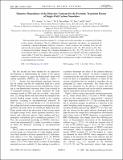| dc.contributor.author | Dresselhaus, Mildred | |
| dc.contributor.author | Jorio, A. | |
| dc.contributor.author | Saito, R. | |
| dc.contributor.author | Sato, K. | |
| dc.contributor.author | Araujo, Paulo Antonio Trinidade | |
| dc.date.accessioned | 2010-02-12T19:59:44Z | |
| dc.date.available | 2010-02-12T19:59:44Z | |
| dc.date.issued | 2009-09 | |
| dc.date.submitted | 2009-04 | |
| dc.identifier.issn | 0031-9007 | |
| dc.identifier.uri | http://hdl.handle.net/1721.1/51761 | |
| dc.description.abstract | The measured optical transition energies Eii of single-wall carbon nanotubes are compared with bright exciton energy calculations. The Eii differences between experiment and theory are minimized by considering a diameter-dependent dielectric constant κ, which comprises the screening from the tube and from the environment. Different κ dependencies are obtained for (E[subscript 11]S, E[subscript 22]S, E[subscript 11]M) relative to (E[subscript 33]S, E[subscript 44]S). A changing environment changes the κ diameter dependence for (E[subscript 11]S, E[subscript 22]S, E[subscript 11]M), but for (E[subscript 33]S, E[subscript 44]S) the environmental effects are minimal. The resulting calculated exciton energies reproduce experimental Eii values within ±70 meV for a diameter range (0.7<dt<3.8 nm) and 1.2<Eii<2.7 eV, thus providing a theoretical justification for Eii, environmental effects and important insights on the dielectric screening in one-dimensional structures. | en |
| dc.language.iso | en_US | |
| dc.publisher | American Physical Society | en |
| dc.relation.isversionof | http://dx.doi.org/10.1103/PhysRevLett.103.146802 | en |
| dc.rights | Article is made available in accordance with the publisher's policy and may be subject to US copyright law. Please refer to the publisher's site for terms of use. | en |
| dc.source | APS | en |
| dc.title | Diameter Dependence of the Dielectric Constant for the Excitonic Transition Energy of Single-Wall Carbon Nanotubes | en |
| dc.type | Article | en |
| dc.identifier.citation | Araujo, P. T. et al. “Diameter Dependence of the Dielectric Constant for the Excitonic Transition Energy of Single-Wall Carbon Nanotubes.” Physical Review Letters 103.14 (2009): 146802. © 2009 The American Physical Society. | en |
| dc.contributor.department | Massachusetts Institute of Technology. Department of Electrical Engineering and Computer Science | en_US |
| dc.contributor.department | Massachusetts Institute of Technology. Department of Physics | en_US |
| dc.contributor.approver | Dresselhaus, Mildred | |
| dc.contributor.mitauthor | Dresselhaus, Mildred | |
| dc.relation.journal | Physical Review Letters | en |
| dc.eprint.version | Final published version | en |
| dc.type.uri | http://purl.org/eprint/type/JournalArticle | en |
| eprint.status | http://purl.org/eprint/status/PeerReviewed | en |
| dspace.orderedauthors | Araujo, P.; Jorio, A.; Dresselhaus, M.; Sato, K.; Saito, R. | en |
| dc.identifier.orcid | https://orcid.org/0000-0001-8492-2261 | |
| mit.license | PUBLISHER_POLICY | en |
| mit.metadata.status | Complete | |
